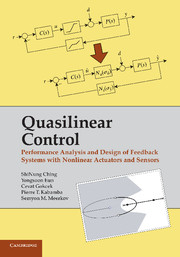 Quasilinear Control
Quasilinear Control Published online by Cambridge University Press: 01 June 2011
Motivation: In designing linear feedback systems, tracking quality specifications are typically mapped into admissible domains in the complex plane and then the root locus technique is used to synthesize a controller that places closed loop poles in the desired locations. This methodology motivates the first goal of this chapter: to generalize the notion of admissible domains and the root locus technique to LPNI systems. Accomplishing this goal leads to a quasilinear method for PID controller design.
Overview: A technique for mapping the random reference tracking quality indicators, introduced in Chapter 3, into admissible domains on the complex plane is introduced (Section 5.1). Next, the root locus method for systems with saturating actuators is developed (S-root locus, Section 5.2). It turns out that the S-root locus is a subset of the usual root locus typically terminating prior to the open loop zeros. A method for calculating these termination points is provided. In addition, we equip the S-root locus with the so-called truncation points, which define its segments where tracking without amplitude truncation is possible.
Admissible Pole Locations for Random Reference Tracking
Scenario
In linear Control Theory, admissible domains for tracking deterministic references are defined using the classical “quality indicators,” that is, overshoot and settling, rise, and delay times. In this section, we develop a similar approach for tracking random references.
To save this book to your Kindle, first ensure [email protected] is added to your Approved Personal Document E-mail List under your Personal Document Settings on the Manage Your Content and Devices page of your Amazon account. Then enter the ‘name’ part of your Kindle email address below. Find out more about saving to your Kindle.
Note you can select to save to either the @free.kindle.com or @kindle.com variations. ‘@free.kindle.com’ emails are free but can only be saved to your device when it is connected to wi-fi. ‘@kindle.com’ emails can be delivered even when you are not connected to wi-fi, but note that service fees apply.
Find out more about the Kindle Personal Document Service.
To save content items to your account, please confirm that you agree to abide by our usage policies. If this is the first time you use this feature, you will be asked to authorise Cambridge Core to connect with your account. Find out more about saving content to Dropbox.
To save content items to your account, please confirm that you agree to abide by our usage policies. If this is the first time you use this feature, you will be asked to authorise Cambridge Core to connect with your account. Find out more about saving content to Google Drive.